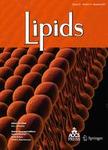版权所有:内蒙古大学图书馆 技术提供:维普资讯• 智图
内蒙古自治区呼和浩特市赛罕区大学西街235号 邮编: 010021

作者机构:Pontificia Univ Catolica Chile Sch Med Dept Nutr Santiago Chile Pontificia Univ Catolica Chile Sch Med Dept Metab & Diabet Santiago Chile Pontificia Univ Catolica Chile Sch Med Dept Obstet & Gynecol Santiago Chile Pontificia Univ Catolica Chile Fac Biol Sci Biochem Cytol & Lipids Lab Santiago Chile
出 版 物:《LIPIDS》 (类脂化合物)
年 卷 期:2000年第35卷第2期
页 面:143-148页
核心收录:
学科分类:0710[理学-生物学] 1004[医学-公共卫生与预防医学(可授医学、理学学位)] 081702[工学-化学工艺] 08[工学] 0817[工学-化学工程与技术]
基 金:Pontificia Universidad Católica de Chile UC (PUC-PBMEC98)
主 题:碱性磷酸酶/血液 肱动脉/药物作用 肱动脉/生理学 膳食 膳食脂肪类/副作用 内皮 血管/药物作用 内皮 血管/生理学 脂肪酸类/血液 脂肪酸类 ω3/血液 水果 高半胱氨酸/血液 硝酸甘油/药理学 转氨酶类/血液 血管舒张/药物作用 血管舒张药/药理学 蔬菜 维生素B12/血液 葡萄酒 γ-谷氨酰转移酶/血液 人类 男(雄)性
摘 要:Endothelial dysfunction is associated with atherogenesis and oxidative stress in humans. In rat and rabbit blood vessels, wine polyphenol antioxidants induce vascular relaxation in vitro through the NO-cCMP pathway. To assess the effect of a regular high-fat diet (HFD) and moderate red wine consumption on endothelial function (EF), a study was performed in healthy male volunteers. EF was measured as flow-mediated dilatation of the brachial artery, employing high-resolution ultrasound after an overnight fast. Other clinical and biochemical parameters related to EF were also measured. Six volunteers received a control diet, rich in fruits and vegetables (27% calories as fat) and five volunteers received an HFD (39.5% calories as fat). Measurements were done twice on each volunteer: after a period of 30 d with diet plus 240 mt of red wine/d, and after a period of 30 d with diet, without wine. In the absence of wine, there is a reduction of EF with HFD when compared to the control diet (P = 0.014). This loss of EF is not seen when both diets are supplemented with wine for 30 d (P = 0.001). Plasma levels of n-3 fatty acids (R-2 = 0.232, P = 0.023) and lycopene (R-2 = 0.223, P = 0.020) show a positive correlation with individual EF measurements, but they do not account for the significant differences observed among dietary groups or after wine supplementation. These results help elucidate the deleterious effect of a high-fat diet and the protective role of wine, n-3 fatty acids and dietary antioxidants in cardiovascular disease.